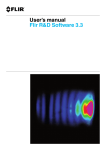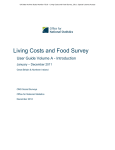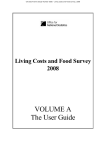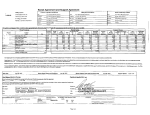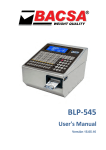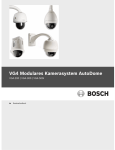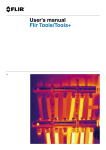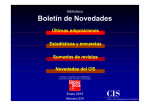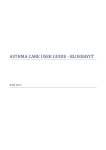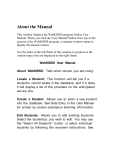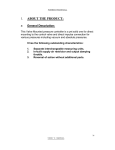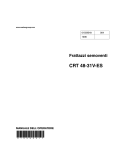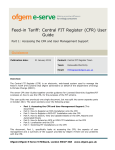Download SECTION 1 User Guide
Transcript
Family Expenditure Survey User Documentation 1995-96 SECTION 1 User Guide Family Expenditure Survey 1995-96 : SECTION 1 USER GUIDE Contents Colour Part 1 - Guide to the 1995-96 User Documentation white Part 2 - The Structure of the 1995-96 Database pink Part 3 - Database Definitions yellow Part 4 - Background to the 1995-96 Family Expenditure Survey blue Part 5 - Survey Definitions green Part 6 - Additional Information salmon Date Produced : 25 February 1999 Contents 1995-96 : SECTION 1, PART 1 Family Expenditure Survey Guide to the 1995-96 User Documentation GUIDE TO THE 1995-96 USER DOCUMENTATION Structure of the User Documentation SECTION 1 - USER GUIDE Part 1 - Guide to the 1995-96 User Documentation Part 2 - The Structure of the 1995-96 Database Part 3 - Database Definitions Part 4 - Background to the 1995-96 Family Expenditure Survey Part 5 - Survey Definitions Part 6 - Additional Information SECTION 2 - THE RAW DATABASE Explanatory note Part 1 - Raw table definitions in table name order Part 2 - Raw variables in variable order Part 3 - Raw variables ordered by variable description Part 4 - Raw variables in question reference order SECTION 3 - THE DERIVED DATABASE Explanatory note Anonymisation in the 1995-96 FES Part 1 - Derived table definitions in table name order Part 2 - Derived variables in variable order Part 3 - Derived variables ordered by variable description Part 4 - Specification of product codes Part 5 - Coding frames for derived codes SECTION 4 - EXPENDITURE CODES Explanatory note Part 1 - Expenditure Codes : Summary Part 2 - Expenditure Codes : Detailed SECTION 5 - DATABASE CHANGES Explanatory note Part 1 - New raw variables for 1995-96 Part 2 - 1994-95 raw codes that have been deleted for 1995-96 Part 3 - 1994-95 raw codes amended for 1995-96 Part 4 - New derived variables for 1995-96 Part 5 - 1994-95 derived variables that have been deleted for 1995-96 Part 6 - 1994-95 derived codes amended for 1995-96 Part 7 - New expenditure codes for 1995-96 Part 8 - 1994-95 expenditure codes amended for 1995-96 Part 9 - New tables for 1995-96 Part 10 - 1994-95 tables that have been deleted for 1995-96 Part 11 - Major changes Part 12 - Questionnaire changes SECTION 6 - VARIABLE RELATIONSHIPS Explanatory note Part 1 - List of target variables showing source variables Part 2 - List of source variables showing targets Date Produced : 4 February 1999 Colour yellow card white pink yellow blue green salmon green card pink white yellow pale pink green orange card pink white white yellow pale pink green blue blue card pink blue yellow red card pink yellow pink green yellow pink green yellow green yellow pink blue white pink card pink white pink Page 1 1995-96 : SECTION 1, PART 1 Guide to the 1995-96 User Documentation Family Expenditure Survey Use of the 1995-96 User Documentation Explanatory notes on the use of the sections of the documentation are given at the beginning of each section. The following gives a summary only. See 'Database Definitions' in Part 3 and 'Survey Definitions' in Part 5 for explanation of terms. SECTION 1 - THE USER GUIDE This section begins with a guide to the contents and the use of the User Documentation (Part 1 - Guide to the 1995-96 User Documentation...YOU ARE HERE). Part 2 explains The structure of the 1995-96 database and includes a useful flow diagram which gives a pictorial summary of the database structure. Part 3 - Database definitions - gives some definitions of the terms used both on the flow diagram and in other parts of the Documentation. Part 4 is Background to the 1995-96 Family Expenditure Survey which includes information on the sampling methodology and non-response. Definitions are given in Part 5 - Survey Definitions. The name and address to contact if you have any queries is given in Part 6 - Additional information, along with details of the other items of User Documentation that are available on request. SECTION 2 - THE RAW DATABASE This section of the User Documentation describes the raw database. The raw database contains data 'as it was received'. That is, before any calculations or aggregations have been carried out. The document is in four parts, as outlined below. Part 1 - Raw table definitions in table name order This part of the document defines the raw tables and gives information on the variables included in each table and the related coding frames. It can be used to look up details of the variables and coding frames when the table name is known. Parts 2 - 4 : Raw variable lists These are variable lists, listing all raw variables and including information on the variable name, description, table name and question reference. These three lists allow details of a variable (such as the table in which it is found, or the question to which it relates) to be looked up if the variable name (Part 2 - ordered by variable name), variable description (Part 3 - ordered by variable description) or question number (Part 4 - ordered by question reference) is known. SECTION 3 - THE DERIVED DATABASE This section of the User Documentation, in five parts, describes the derived database. A summary of anonymisation, particularly in relation to council tax, is also given following the explanatory notes. Part 1 - Derived table definitions in table name order This part of the document defines the derived tables and gives information on the variables included in each table and the related coding frames. It can be used to look up details of the variables and coding frames when the table name is known. Parts 2 and 3 : Derived variable lists These are variable lists, listing all derived variables and including information on the variable name, description, table name and coding frame (where relevant). These two lists allow details of a variable to be looked up if the variable name (Part 2 - ordered by variable name) or variable description (Part 3 - ordered by variable description) is known. Page 2 Date Produced : 4 February 1999 1995-96 : SECTION 1, PART 1 Family Expenditure Survey Guide to the 1995-96 User Documentation Part 4 - P-codes Product codes (or p-codes) are aggregated codes, some at household level and some at personal level. Part 4 gives descriptions of these codes in 'English' as an aid to understanding their structure. Part 5 - Coding frames This part of the document gives definitions of some of the more important coding frames, along with the names of the variables which make use of them. SECTION 4 - EXPENDITURE CODES In the Family Expenditure Survey, information about expenditure is collected at a detailed level. It is collected through both the diary (which respondents fill in daily for a fortnight) and through the Household Questionnaire. Items of expenditure are assigned a six digit code which represents the type of expenditure (the code might represent 'bread', 'mortgage payments' or 'visits to the cinema', for example). These six digit codes are listed in Part 1 of this section - Expenditure Codes : Summary. Part 2 of this section - Expenditure Codes : Detail - is the 'data dictionary'. It gives an indication of the types of items to be found under each expenditure code. SECTION 5 - DATABASE CHANGES Section 5 of the User Documentation describes the changes that have taken place in the 1995-96 database when compared with 1994-95. Several major changes have been introduced for 1995-96. For example, Council Tax and Council Tax water payments are now fully anonymised on the database. This means that total housing expenditure and therefore total expenditure are now available on the database using these anonymised data. In previous years housing expenditure has been excluded as anonymised Council Tax data were not an integral part of the dataset. Parts 1 and 4 show New Raw variables for 1995-96 and new derived variables for 1995-96. Parts 2 and 5 show 1994-95 raw variables that have been deleted for 1995-96 and 1994-95 derived variables that have been deleted for 1995-96. Parts 3 and 6 show 1994-5 raw variables amended in 1995-96 and 1994-5 derived variables amended in 1995-96. Part 7 shows the new expenditure codes for 1995-96 and Part 8 shows the 1994-95 expenditure codes amended in 1995-96. Part 9 shows the new tables for 1995-96 and Part 10 shows the 1994-95 tables that have been deleted from the 1995-96 dataset. Part 11 - Major changes, highlights some of the more important definitional changes for 1995-96. Part 12 - Questionnaire changes is based on a paper produced by SSD and describes question deletions, additions and wording changes that have been implemented for the 1995-96 questionnaires. SECTION 6 - VARIABLE RELATIONSHIPS Section 6 of the User Documentation shows the relationships between variables within the dataset. Part 1 of this section shows which raw variables are used to make up derived variables and Part 2 lists raw variables which are used in derived variables. Date Produced : 4 February 1999 Page 3 1995-96 : SECTION 1, PART 1 Guide to the 1995-96 User Documentation OTHER ITEMS OF DOCUMENTATION PROVIDED TO USERS - Household Questionnaire - Income Questionnaire - The FES Diary (adult and young person's) - FES Interview Prompt Cards - Household Questionnaire - Interviewers Instructions & Editing Notes - Income Questionnaire - Interviewers Instructions & Editing Notes - FES Diary - instructions to interviewers - FES Diary - editing notes Page 4 Date Produced : 4 February 1999 Family Expenditure Survey If you have any queries relating to the 1995-96 FES database please contact the FES team on 0171 217 4184/4244 Contents Date Produced : 4 February 1999 1995-96 : SECTION 1, PART 2 The structure of the 1995-96 database Family Expenditure Survey THE STRUCTURE OF THE 1995-96 DATABASE For definitions of the terms used here, please see Part 3 - Database definitions. Outline of the structure of the FES database 1995-96 In the FES database, variables are grouped to form a number of different TABLES. The raw tables contain data as it is received from Social Survey Division (ONS) and the derived tables contain processed data. The attached flow diagram - OUTLINE OF THE STRUCTURE OF THE FES DATABASE 1995-96, gives an approximation of the location of different categories of data and the flow of data between the tables that comprise the database (data flow is shown by the arrows). It should be noted that it gives general flows only and is not definitive. The boxes that are contained in the orange box (surrounded by the dotted line) represent raw data that is collected through both the diary and the questionnaires. It can be seen that there are raw data tables relating to diary expenditure, credit card expenditure, loans and so on. Definitions of the raw database are to be found in SECTION 2 of the User Documentation. ALL of the boxes OUTSIDE the orange area (i.e. those not contained within the dotted line) represent derived data. All derived table names are pre-fixed 'SET' and definitions are to be found in SECTION 3 of the User Documentation. Eight such tables are named individually on the flow diagram because they play key roles in the data processing procedure, as described below. All boxes contained in the purple area make use of the EXPENDITURE CODES (as detailed in User Documentation Section 4) either as a coding frame (called expend_keytext1) or as a variable (where the code is pre-fixed 'd'). The data flow For definitions of expenditure relating to loans, hire purchase and credit clubs etc. (SET87, SET86 and SET88) please see Part 5 - Survey Definitions. The diary data is entered into the computer and forms the diary raw data tables. At this stage, every separate instance of expenditure by every person is represented by a separate 'record' or 'row' and is assigned an EXPENDITURE CODE that indicates the type of item purchased and the type of transaction (e.g. cash, credit card, business expense). See Section 4 for information on expenditure codes. Data at this level is not provided in the user dataset. SET114 is the first derived table for the diary data and here the data are more aggregated: instead of having a separate row for every instance of expenditure, there are now only two rows for each person for each separate expenditure code and each transaction type: one row represents the total expenditure by that person on that code in week 1 and the other represents the expenditure in week 2. Following SET114, the diary data that relates to expenditure codes for which data are also collected through the questionnaires are re-directed to SET900 to avoid double counting. They are not used in any further tables. In SET89 (adults) and SET89C (children), some expenditure relating to the expenditure codes but collected through the questionnaires is added to that collected through the diary. In this set, Page 1 Date Produced : 4 February 1999 there is only one row per expenditure code which represents the average weekly expenditure for each person on items in that code. This SET feeds into various D-CODE tables. In these, the expenditure codes become VARIABLES and are pre-fixed with 'D'. The four boxes in the centre of the flow-diagram represent various levels of aggregated variables at both household and personal level. Information from the questionnaires not previously included feeds in at this level (from the two raw data boxes in the lower right corner of the diagram). Details on p-codes are given in Part 4 of Section 3 of the Documentation. 1995-96 : SECTION 1, PART 2 The structure of the 1995-96 database Family Expenditure Survey THIS PAGE HAS BEEN DELIBERATELY LEFT BLANK Page 3 Date Produced : 4 February 1999 1995-96 : SECTION 1, PART 3 Family Expenditure Survey Database definitions DATABASE DEFINITIONS The raw database The raw database contains data 'as it was received' from Social Survey Division. At this stage, weekly equivalent dv values have been calculated for questionnaire data (see note on 'weekly equivalent values' on page 3) and some imputation has been carried out by Social Survey Division. The raw database is defined in Section 2 of the User Documentation. The derived database The derived database consists of variables that have been adjusted in some way in relation to the state in which they were received from Social Survey Division. This adjustment might involve only a change in name, or it might involve some calculation or aggregation. The derived database is defined in Section 3 of the User Documentation. Variable name The variable name (sometimes just written 'variable' in the documentation) is the database reference name of the variable. Variable lists ordered by variable name can be found in Part 2 of both Section 2 and Section 3 of the User Documentation. Variable description The variable description is a brief description in 'English' of the variable. Variable lists ordered by variable description can be found in Part 3 of both Section 2 and Section 3 of the User Documentation. Table In the FES database, the data is stored in a number of different TABLES. Usually, a single table contains information on a number of variables that are related to one another in some way. An example is the table called 'rents1' which contains information about rented accommodation (table rents2 contains further rents information). Conceptually, a table can be perceived as consisting of rows and columns: the 'column headings' are the names of the variables contained in that table and each 'row' represents an individual 'record'. A 'row' or 'record' is uniquely labelled in terms of the 'SORT KEYS' for that table. If the sort keys are, for example, caseno (case number), persno (person number) and itemnum (item number) then there is a separate row in the table not only for every case, but for every person within that case and for every item purchased by that person. The raw data tables are defined in Part 1 of Section 2 of the User Documentation and the derived data tables are defined in Part 1 of Section 3. Table name Date Produced : 25 February 1999 Page 1 1995-96 : SECTION 1, PART 3 Database definitions Family Expenditure Survey The table name is the database reference name of the table. Page 2 Date Produced : 25 February 1999 1995-96 : SECTION 1, PART 3 Family Expenditure Survey Database definitions Tables suffixed 'c' These are tables containing information collected on child expenditure, where the child is aged between 7 and 15 and completed a diary. The variables in these tables are related to one another in some way and all are suffixed 'c'. Tables suffixed 't' These are tables containing information collected on total expenditure (children and adults). Each variable contained within these tables are suffixed 't' and represent data where the original (adult) variable has been added to those for children. Sort keys Sort keys are simply variables, but in the context of a table they have a special meaning: they are the variables that are needed to uniquely define a 'row' within the table. The sort keys are indicated in the table definitions in Part 1 of Sections 2 and 3 where they are listed under 'sort keys' and not under 'variables'. See the description of TABLE above for more detail. Coding frame If a variable has a coding frame, it means that it is allowed to take on only certain permitted values (i.e. the variable is not a 'free' field). The name of a coding frame is usually the same as the name of the variable using it, however, the more commonly used coding frames have their own names. These named coding frames are listed in Part 5 (Coding Fames) of Section 3 of the User Documentation, along with the names of the variables which make use of them. Details of other coding frames can be found in the table definition of the table in which the related variable is located. Table definitions are given in Part 1 of Section 2 and 3 of the User Documentation. The table in which a variable is located can be found by using the variable lists in Part 2 or 3 of Sections 2 and 3. Question reference The question reference is the question number relating to the variable, as contained within the Household (if pre-fixed by H) or Income (if pre-fixed by I) Questionnaire. Only raw variables have a question reference. If a raw variable does not have a question reference, one of the following will be given instead: - 'diary' if the variable relates to diary data - 'sort key' if the variable is a sort key (see note on 'sort keys' above) - 'system' if the variable is a system variable used only for editing purposes (and therefore probably not of use to users of the database) A list of variables ordered by Documentation. question reference is given in Part 4 of Section 2 of the User Anonymisation Date Produced : 25 February 1999 Page 3 1995-96 : SECTION 1, PART 3 Database definitions Family Expenditure Survey Variables which could lead to the identification of a household or an individual are not released to users. An 'anonymised' version of sensitive derived variables is provided in the user dataset. Variables which have been anonymised can be identified because they are suffixed 'p'. Unanonymised versions are suffixed 'u' and are not accessible to external users of the FES. The principles of anonymisation, particularly in relation to council tax, are explained in Section 3 of the User Documentation. Page 4 Date Produced : 25 February 1999 1995-96 : SECTION 1, PART 3 Family Expenditure Survey Database definitions Expenditure codes Each expenditure amount collected through the diary and some collected through the questionnaire are given a code which represents the type of item that was purchased. The expenditure codes make up a coding frame called expend_keytext1. Variables representing household aggregates of the expenditure codes are called d-codes (or d-variables): the variable name is the expenditure code pre-fixed with 'd'. A complete listing of the expenditure codes and more details on their use can be found in Section 4 (Expenditure Codes) of the User Documentation. 'A' and 'B' codes A-codes and B-codes are aggregate codes, some at household level and some at personal level. They are all derived codes and so are listed in Section 3 (The Derived Database) of the User Documentation. The fact that they are pre-fixed 'a' or 'b' has no significant meaning. Product codes (p-codes) Product codes (or p-codes) are aggregate codes, some at household level and some at personal level. Part 4 of Section 3 of the User Documentation gives descriptions of these codes in 'English' as an aid to understanding their structure, along with more detailed explanatory notes on their use. Codes suffixed 'c' These codes represent the expenditure of children, aged between 7 and 15, who completed a diary. The codes are aggregated to household level. Variables suffixed 'c' are only available as expenditure or product codes. Codes suffixed 't' These codes represent total expenditure by children and adults. They are aggregated to household level by adding the original (adult) variable to those suffixed 'c', (i.e. p522 + p522c = p522t). Variables suffixed 't' are only available as expenditure code or product codes. Codes suffixed 'cq' These codes represent the total expenditure of children, aged between 7 and 15, who completed a diary. The codes are aggregated to a personal level. All variables have been set up specifically for Family Spending and are stored in the table SET300c. 'T' codes T-codes are used only for the preparation of the publication 'FAMILY SPENDING'. Weekly equivalent values So that expenditure from different sources can be aggregated, it is necessary for all expenditure amounts to be on an equivalent basis. In order to achieve this, all expenditure amounts collected Date Produced : 25 February 1999 Page 5 1995-96 : SECTION 1, PART 3 Database definitions Family Expenditure Survey through the questionnaire are converted to WEEKLY EQUIVALENT VALUES. In the dataset, weekly equivalent values can be identified because they are pre-fixed 'DV'. Information on weekly equivalent values is included as part of the questionnaire. Weekly equivalent values are RAW variables and so are listed in Section 2 of the User Documentation. Page 6 Date Produced : 25 February 1999 1995-96 : SECTION 1, PART 3 Family Expenditure Survey Database definitions Period codes Where expenditure amounts are not given on a weekly equivalent basis, a weekly equivalent is calculated by dividing the amount given by the appropriate period. The standard period codes are coding frame 18 and can be found in Part 5 of Section 3 of the User Documentation. Household questionnaire The Household Questionnaire must be completed for EVERY adult in the household. The household questionnaire collects information on household characteristics and the characteristics of the individuals living there. Also collected through the Household Questionnaire is information on mortgages, rents, bills, insurance policies, loans, hire purchase, standing orders, season tickets and other irregular expenditure such as that on cars or home improvements. Information on the irregular purchases is often obtained through retrospective recall (i.e. the question may be 'when did you last purchased a ....... ?'). Expenditure on retrospective recall is converted to a weekly equivalent value. That is, if the recall period is one year, then the weekly equivalent value is calculated by dividing by 52. See the Household Questionnaire for details on questions and recall periods. Income Questionnaire The Income Questionnaire must be completed for EVERY adult in the household. The income questionnaire collects information on the income of the individuals in the household and the household as a whole. See 'Survey Definitions', Section 1, Part 5 for income definitions. Diary The diary is completed by every spender. It is completed daily for 14 days and all expenditure in that period is recorded. See 'Expenditure' in 'Survey Definitions', Section 1, Part 5 for further information on the collection of data through the diary. Date Produced : 25 February 1999 Page 7 1995-96 : SECTION 1, PART 4 Family Expenditure Survey Background to the 1995-96 Family Expenditure Survey BACKGROUND TO THE 1995-96 FAMILY EXPENDITURE SURVEY This background note also appears as Appendix A of FAMILY SPENDING 1995-96 The survey The Family Expenditure Survey (FES) is a voluntary sample survey of private households. The basic unit of the survey is the "household" which is defined as a group of people living at the same address, with common housekeeping e.g. sharing household expenses such as food and bills (see 'Survey Definitions', Section 1, Part 5). Each individual aged 16 or over in the household visited is asked to keep diary records of daily expenditure for two weeks. For the first time in 1995-96 children aged between 7 and 15 were also asked to complete simplified diaries of their daily expenditure. Details about regular expenditure and income are also obtained by interviewing all adult members of the household. To set the spending information in perspective, detailed questions are asked about the income of each adult member of the household. This enables households to be classified by their total income. In addition, personal information such as age, sex and marital status is recorded for each household member. The survey has been conducted each year since 1957. The survey is continuous; interviews are spread evenly over the year to ensure that seasonal expenditure changes are covered. From time to time, changes are made to the information sought. Some changes reflect new forms of expenditure or new sources of income, especially benefits. The survey data may therefore not provide a consistent time series, and care should be taken when making comparisons over time. The sample design The FES sample for Great Britain is a stratified clustered random sample drawn from the small users file of the Postcode Address File - the Post Office's list of addresses. All Scottish offshore islands and the Isle of Scilly are excluded from the sample because of excessive travel costs. Postal sectors (ward size) are the primary sample unit. 672 postal sectors are randomly selected during the year after being arranged in strata defined by standard regions, area type, and two 1991 Census variables (proportion of owner-occupiers and proportion of renters). The Northern Ireland sample is drawn as a random sample of addresses from Rating and Valuation lists. Response to the survey Some 10,000 households are selected each year to be invited to take part in the FES. It is never possible to cover the entire sample selected. A small number cannot be contacted at all, and in other households one or more members decline to co-operate. In all, some 7,000 households in the UK, or about 70 per cent of those contacted, co-operate fully in the survey each year i.e. they complete both the diary and the questionnaire. Details of response in Great Britain to the 1995-96 survey are shown in the following table: Date Produced : 25 February 1999 Page 1 1995-96 : SECTION 1, PART 4 Background to the 1995-96 Family Expenditure Survey Family Expenditure Survey Response in 1995-96 i. ii. iii. iv. v. vi. Page 2 Sampled households Ineligible households, hotels, institutions, empty demolished/derelict Effective sample (i.e. i less ii) Co-operating households Refusals Households at which no contact could be obtained No of households % of effective sample 11,611 1,461 - 10,150 6,663 3,222 265 100 65.6 31.7 2.6 Date Produced : 25 February 1999 1995-96 : SECTION 1, PART 4 Family Expenditure Survey Background to the 1995-96 Family Expenditure Survey In the Northern Ireland Survey, the effective sample was 1,087 households. The number of cooperating households was 659, giving a response rate of 60.6 per cent. Out of the co-operating households, 134 were selected at random to form part of the UK FES giving a total UK sample of 6,797 households. The fieldwork The fieldwork is carried out by the Social Survey Division of the Office for National Statistics (ONS) in Great Britain and by the Northern Ireland Statistics and Research Agency of the Department of Finance and Personnel in Northern Ireland using almost identical questionnaires. Households at the selected addresses are visited and asked to co-operate in the survey. A detailed questionnaire covers household topics and income information. Interviews are now conducted using portable computers with the questions being asked using computer assisted personal interviewing (CAPI), rather than using paper questions. Information is collected about the household, about incomes, and about certain regular payments such as rent, gas, electricity and telephone accounts, licences and insurance, education, season tickets and hire-purchase during the interview. Each individual aged 16 or over in the household keeps a detailed record of expenditure every day for two weeks. Children aged between 7 and 15 were asked on a voluntary basis to keep a diary of daily expenditure. The information provided is kept strictly confidential. If all persons aged 16 and over in the household co-operate each is subsequently paid ,10 for the trouble involved in supplying the information. Children who keep a diary are given a ,5 payment. A refusal by an under 16 to keep a diary does not invalidate the household from inclusion in the survey. A total of 2,224 children aged between 7 and 15 were asked to complete expenditure diaries, only 39 or about 2 per cent refused. Reliability Great care is taken in collecting information from households and comprehensive checks are applied during processing, so that errors in recording and processing are minimal. The main types of error that affect the reliability of the survey results are sampling errors, non-response bias and some incorrect reporting of certain items of expenditure and income. There is evidence indicating that some characteristics of the households who decline to respond to the survey differ from those who co-operate. It is therefore possible that their patterns of 1 expenditure and income also differ. A comparison has been made of the households responding in the 1991 FES with information from the Census of Population. Results from the study indicate that response was lower than average in Greater London, and higher in non-metropolitan areas. Non-response tended to increase with increasing age of the head of the household, up to age 65. Households which contained three or more adults, or where the head was born outside the United Kingdom, or was classified to an ethnic minority group were more likely than others to be nonresponding. Non-response was also above average where the head of the household had no postschool qualifications, was self-employed, or was in a manual social class group. It is thought that averages of household income recorded in the FES are too low, principally because certain forms of income, including investments, occupational pensions or self2 employment, may be under-estimated. Evidence for this is limited; for example studies have shown that earnings data in the survey tend to be slightly deficient. The main identified weaknesses in the survey were found to be an understatement of earnings by women in part-time employment, and an under-representation of the highest one per cent of earners. However, FES levels are generally within a few per cent of levels indicated by other sources such as the Family 1 A Comparison of the Census characteristics of respondents and non-respondents to the 1991 The Family Expenditure Survey by Kate Foster, Survey Methodology Bulletin, ONS, No. 38, Jan 1996. 2 See the Distribution of earnings of Employees in Great Britain by A R Thatcher (Journal of the Royal Society, Series A, Vol 131, 1968); On the reliability of income data in the Family Expenditure Survey 1970-1977 by A B Atkinson and J Micklewright (Journal of the Royal Statistical Society, Series A, Vol 146, 1983); and Family Expenditure Survey Handbook (1980). Date Produced : 25 February 1999 Page 3 1995-96 : SECTION 1, PART 4 Background to the 1995-96 Family Expenditure Survey Family Expenditure Survey Resources Survey (the Department of Social Security), and the New Earnings Survey and Labour Force Survey (ONS), and national income statistics. Page 4 Date Produced : 25 February 1999 1995-96 : SECTION 1, PART 4 Family Expenditure Survey Background to the 1995-96 Family Expenditure Survey It must be emphasised that the FES is primarily a survey of expenditure on goods and services by households. The information obtained by the survey does not permit the construction of household accounts in the form of an income-expenditure balance sheet for a specific period. Information which is obtained about income is used primarily to classify households into income groups, in order that separate analyses of expenditure can be made for these groups of households. The definitions of weekly household expenditure and income used are such that it is not to be expected that expenditure and income will balance, either for an individual household or even when averaged over a group of households. Hence, the difference between expenditure and income is not a measure of savings or dis-savings. Experience of household surveys in the United Kingdom and in other countries indicates that reported expenditure on a few items (notably alcohol and tobacco) is below the levels which might be expected by comparison with other sources of information. For example, the estimated average expenditure of all households in the FES on beer is about two-thirds of corresponding estimates from statistics produced by HM Customs and Excise. Chapter 14 of the FES Handbook (Kemsley, Redpath and Holmes) examines the possible causes of the understatement of alcohol and tobacco expenditure in the FES results, as well as other problems of understatement. It concludes that it is mainly due to non-response by very heavy drinkers and smokers. There is some evidence to suggest that the non-response bias in alcohol expenditure increased in 1995-96 due to higher non-response. Changes to the wording of the expenditure diary may also have caused respondents to under-record the total amount spent on alcohol. Additionally, these changes may have caused respondents to be less precise in their descriptions, leading to an increase in the amount recorded as >other drinks= rather than specific items eg, wine and beer. The survey is also thought to understate expenditure on confectionery, soft drinks and ice-cream. One contributory factor is that the purchase of these items by children from pocket money will usually be recorded simply as pocket money since children under 16 do not keep expenditure records. National Lottery spending is significantly under-recorded in the FES. Purchases of tickets for the Saturday night draw are well-recorded; but under-recording of scratchcards is acute. Date Produced : 25 February 1999 Page 5 1995-96 : SECTION 1, PART 5 Family Expenditure Survey Survey definitions SURVEY DEFINITIONS These definitions also appear in Appendix D of FAMILY SPENDING 1995-96. Household A household comprises one person living alone or a group of people living at the same address having meals prepared together and with common housekeeping. Resident domestic servants are included. The members of a household are not necessarily related by blood or marriage. As the survey covers only private households, people living in hostels, hotels, boarding houses or institutions are excluded. Households are not excluded if some or all members are not British subjects, but no attempt is made to obtain information from households containing members of the diplomatic service of another country or members of the United States armed forces. Nor are attempts made to obtain information from Roman Catholic priests living in accommodation provided by the parish church. Retired households Retired households are those where the head of the household is retired. All male heads of household are 65 years of age or more; all female heads of household are 60 years of age or more. For analysis purposes two categories are used in this report: a. "A retired household mainly dependent upon state pensions", also known as a pensioner household, is one in which at least three quarters of the total income of the household is derived from national insurance retirement and similar pensions, including housing and other benefits paid in supplement to or instead of such pensions. The term "national insurance retirement and similar pensions" includes national insurance disablement and war disability pensions, and income support in conjunction with these disability payments. In a small number of cases it also covers unemployment, sickness and industrial injury benefits paid to men and women over retirement age. A small proportion of persons in these households may be working a few hours a week. b. "Other retired households" are households which do not fulfil the income conditions of "pensioner" households because more than a quarter of the household's income derives from occupational retirement pensions and/or income from investments, annuities etc. Head of household The head of the household must be a member of that household. He/she is the person, or the husband of the person who: a. owns the household accommodation, or b. is legally responsible for the rent of the accommodation, or c. has the household accommodation as an emolument or perquisite, or d. has the household accommodation by virtue of some relationship to the owner who is not a member of the household. When two members of different sex have equal claim, the male is taken as head of household. When two members of the same sex have equal claim, the elder is taken as head of household. Members of household Date Produced : 4 February 1999 Page 1 1995-96 : SECTION 1, PART 5 Survey definitions Family Expenditure Survey In most cases the members of co-operating households are easily identified as the people who satisfy the conditions in the definition of a household, above, and are present during the recordkeeping period. However, difficulties of definition arise where people are temporarily away from the household or else spend their time between two residences. The following rules apply in deciding whether or not such persons are members of the household: Page 2 Date Produced : 4 February 1999 1995-96 : SECTION 1, PART 5 Family Expenditure Survey Survey definitions married persons living and working away from home for any period are included as members provided they consider the sampled address to be their main residence; in general, other people (e.g. relatives, friends, boarders) who are either temporarily absent or who spend their time between the sampled address and another address, are included as members if they consider the sampled address to be their main residence. However, there are exceptions which override the subjective main residence rule: i. Children under 16 away at school are included as members; ii. Older persons receiving education away from home, including children aged 16 and 17, are excluded unless they are at home for all or most of the recordkeeping period. iii. Visitors staying temporarily with the household and others who have been in the household for only a short time are treated as members provided they will be staying with the household for at least one month from the start of record-keeping. Household composition A consequence of these definitions is that household compositions quoted in this report include some households where certain members are temporarily absent. For example, "one adult and children" households will contain a few households where one parent is temporarily away from home. Adult Persons who have reached the age of 18 or who are married are classed as adults. Children Persons who are under 18 years of age and unmarried are classed as children. However, in the definition of clothing, clothing for persons aged 16 years and over is classified as clothing for men and women; clothing for those aged five but under 16 as clothing for boys and girls; and clothing for those under five as babies. Spenders Members of households who are aged 16 or more, excluding those who for special reasons are not capable of keeping diary record-books, are described as spenders. Economically active These are persons aged 16 or over who fall into the following categories: a. Employees at work - those who at the time of interview were working full-time or part-time as employees or were away from work on holiday. Part-time work is defined as normally working 30 hours a week or less (excluding meal breaks) including regularly worked overtime. b. Employees temporarily away from work - those who at the time of interview had a job but were absent because of illness or accident, temporary lay-off, strike etc. c. Government training schemes - those participating in government programmes and schemes who in the course of their participation receive training, such as Employment Training, including those who are also employees in employment. Date Produced : 4 February 1999 Page 3 1995-96 : SECTION 1, PART 5 Survey definitions Family Expenditure Survey d. Self-employed - those who at the time of interview said they were self-employed. e. Unemployed - those who at time of interview were out of employment, and have sought work within the last four weeks and were available to start work, or were waiting to start a job already obtained. f. Unpaid family workers - those working unpaid for their own or a relative=s business. For variables using coding 13 'Economic Position' (see Section 3, Part 5 of the User Documentation), unpaid family workers are included under economically inactive because insufficient information is available to assign them to an economic status group. Economically inactive a. Retired - persons who have reached national insurance retirement age (60 and over for women, 65 and over for men) and are not working. b. Unoccupied - persons under national insurance retirement age who are not working, nor actively seeking work. This category includes certain self-employed persons such as mail order agents and baby-sitters who are not classified as economically active. For variables using coding frame 13 'Economic Position' (see Section 3, Part 5 of the User Documentation), unpaid family workers are included under economically inactive, although they are economically active by definition. This is because insufficient information is available to assign them to an economic status group. Occupation (variables using coding frame 7) The occupational classification used in the survey is the socio-economic groups defined in the Classification of Occupations (1990) prepared by the Office for National Statistics. Separate results are shown for the following groups: professional workers; employers and managerial workers; intermediate non-manual workers; junior non-manual workers; skilled manual workers; semiskilled manual workers; unskilled manual workers; Armed Forces. As far as possible occupation is classified according to an individual's current or most recent job; if an individual has more than one job, the most remunerative is used as the basis for the classification. Social Class (variables using coding frame 8) Social class is based on occupation and is a classification system that has grown out of the original Registrar-General's social class classification. These are defined in the Classification of Occupations (1990) prepared by the Office for National Statistics. The 5 categories are: I. II. III. IV. V. Professional, etc. occupations Managerial and technical occupations Skilled occupations (N) non-manual (M) manual Partly skilled occupations Unskilled occupations For the FES, social class of a household refers to the social class based on the occupation of the head of household where the head is economically active. Where the head is not economically active, the household is allocated to a separate category of "retired and unoccupied". Regions (variables using coding frame 11) These are the standard regions for statistical purposes as they exist following the reorganisation of Page 4 Date Produced : 4 February 1999 1995-96 : SECTION 1, PART 5 Family Expenditure Survey Survey definitions local government in 1974-75 and are defined in detail in Regional Trends No 30 1995. Types of administrative area (variables using coding frame 1) These are Greater London, former Metropolitan Counties in England with the Central Clydeside Conurbation in Scotland, and non-metropolitan districts with high and low population densities, i.e. 3.2 persons or more, and less than 3.2 persons, per acre respectively (7.9 persons per hectare). The types of administrative area are defined by the Office for National Statistics on the basis of the definitions of local authority areas and the Central Clydeside Conurbation used by the Registrars General for England and Wales, Scotland, and Northern Ireland. Since the 1989 survey, local authorities in England and Wales and in Scotland are those existing after the reorganisation of local government in 1974 and 1975. For Northern Ireland local authority areas as they existed after the reorganisation of local government in 1973 are used, classified by the population density factors applied generally in the United Kingdom. All Northern Ireland districts are treated as non-Metropolitan. Expenditure Any definition of expenditure is to some extent arbitrary, and the inclusion of certain types of payment is a matter of convenience or convention depending on the purpose for which the information is to be used. Total expenditure represents current expenditure on goods and services. Total expenditure, defined in this way, excludes those recorded payments which are really savings or investments (e.g. purchases of national savings certificates, life assurance premiums, contributions to pension funds). Similarly, income tax payments, national insurance contributions, mortgage capital repayments and other payments for major additions to dwellings are excluded. Expenditure data are collected in the diary record-book and in the household schedule. Informants are asked to record in the diary any payments made during the 14 days of record-keeping, whether or not the goods or services paid for have been received. Certain types of expenditure which are usually regular though infrequent, such as insurance, licences and season tickets, and the periods to which they relate, are recorded in the household schedule. The cash purchase of motor vehicles is also entered in the household schedule. In addition, expenditure on some items purchased infrequently (thereby being subject to high sampling errors) has been recorded in the household schedule using a retrospective recall period of either three or 12 months. These items include carpets, furniture, holidays and some housing costs. In order to avoid duplication, all payments shown in the diary record-book which relate to items listed in the household or income schedules are excluded from derived tables (with the exception of SET27 and SET114) irrespective of whether there is a corresponding entry on the latter schedules. Amounts paid in respect of periods longer than a week are converted to weekly values the variables names of which are given the pre-fix 'dv'. Expenditure codes which are used in the database to describe categories of expenditure are numbered hierarchically according to the main commodity groups. Details of the expenditure codes are given in Section 4 of the User Documentation. Qualifications which apply to this concept of expenditure are described in the following paragraphs: a. Goods supplied from a household's own shop or farm Spenders are asked to record and give the value of goods obtained from their own shop or farm, even if the goods are withdrawn from stock for personal use without payment. The value is included as expenditure. b. Hire purchase and credit sales agreements, and transactions financed by loans repaid by instalments Date Produced : 4 February 1999 Page 5 1995-96 : SECTION 1, PART 5 Survey definitions Family Expenditure Survey Expenditure on transactions under their purchase or credit sales agreements, or financed by loans repaid by instalments, consists of all instalments which are still being paid at the date of interview, together with down payments on commodities acquired within the preceding three months. These two components (divided by the periods covered) provide the weekly averages which are included in the expenditure on the separate items given in the tables in this report. c. Club payments and budget account payments, instalments through mail order firms and similar forms of credit transaction When goods are purchased by forms of credit other than hire purchase and credit sales agreement, the expenditure on them may be estimated either from the amount of the instalment which is paid or from the value of the goods which are acquired. Since the particular commodities to which the instalment relates may not be known, details of goods ordered through clubs, etc. during the month prior to the date of interview are recorded in the household schedule. The weekly equivalent of the value of the goods is included in the expenditure on the separate items given in the tables in this report. This procedure has the advantage of enabling club transactions to be related to specific articles. Although payments into clubs, etc. are shown in the diary record-book, these entries are excluded from expenditure estimates. Page 6 Date Produced : 4 February 1999 1995-96 : SECTION 1, PART 5 Family Expenditure Survey d. Survey definitions Credit card transactions From 1988 purchases made by credit card or charge card have been recorded in the survey on an acquisition basis rather than the formerly used payment basis. Thus, if a spender acquired an item (by use of credit/charge card) during the two week survey period, the value of the item would be included as part of his expenditure whether or not he made any payment in this period to his credit card account. On the other hand, if he made any payment (in whole or in part) to his credit card account covering an item not acquired in the two week survey period then the value of this item, and the payment to the credit card amount for it, would be ignored. Any payment of credit/charge card interest is included in expenditure if made in the two week period. e. Income Tax Amounts of income tax deducted under the PAYE scheme or paid directly by those who are employers or self-employed are recorded (together with information about tax refunds). For employers and the self-employed the amounts comprise the actual payments made in the previous twelve months and may not correspond to the tax due on the income arising in that period, e.g. if no tax has been paid but is due or if tax payments cover more than one financial year. However, the amounts of tax deducted at source from some of the items which appear in the Income Schedule are not directly available. Estimates on the tax paid on bank and building society interest and amounts deducted from dividends on stocks and shares are therefore made by applying the appropriate rates of tax. In the case of income tax paid at source on pensions and annuities, similar adjustments are made. These estimates mainly affect the relatively few households with high incomes from interest and dividends, and those including persons receiving pensions from previous employment. f. Rented dwellings Housing expenditure is taken as the sum of expenditure on rent, rates, council tax, water rates etc. For local authority tenants the expenditure is gross rent less any rebate (including rebate received in the form of housing benefit), and for other tenants gross rent less any rent allowance received under statutory schemes including the Housing Benefit Scheme. Rebate on rates/council tax/water rates is deducted from expenditure on rates/council tax/water rates. Receipts from sub-letting part of the dwelling are not deducted from housing costs but appear (net of the expenses of the sub-letting) as investment income. g. Rent-free dwellings Payments for rates and, council tax, water rates etc., are regarded as the cost of housing. Rebate on rates /council tax/water rates (including rebate received in the form of housing benefit), is deducted from expenditure on rates /council tax/water rates. Receipts from sub-letting part of the dwelling are not deducted from housing costs but appear (net of the expenses of the subletting) as investment income. h. Owner-occupied dwellings Payments for rates, council tax, water rates, ground rent, mortgage interest payments, insurance of structure etc., are regarded as the cost of housing. Rebate on rates/council tax/water rates (including rebate received in the form of housing benefit), is deducted from expenditure on rates/council tax/water rates. Receipts from letting part of the dwelling are not deducted from housing costs but appear (net of the expenses of the letting) as investment income. Mortgage capital repayments and amounts paid for the outright purchase of the dwelling or for major structural alterations are not included as housing expenditure, but are entered under "Other payments recorded". i. Second-hand goods and part-exchange transactions Date Produced : 4 February 1999 Page 7 1995-96 : SECTION 1, PART 5 Survey definitions Family Expenditure Survey The survey expenditure data are based on information about actual payments and therefore include payments for second-hand goods and part-exchange transactions. New payments only are included for part-exchange transactions, i.e. the costs of the goods obtained less the amounts allowed for the goods which are traded in. Receipts for goods sold or traded in are not included in income. Page 8 Date Produced : 4 February 1999 1995-96 : SECTION 1, PART 5 Family Expenditure Survey j. Survey definitions Business expenses The survey covers only private households and is concerned with payments made by members of households as private individuals. Spenders are asked to state whether expenditure which has been recorded on the schedules includes amounts which will be refunded as expenses from a business or organisation or which will be entered as business expenses for income tax purposes, e.g. rent, telephone charges, travelling expenses, meals out. Any such amounts are deducted from the recorded expenditure in the derived tables (with the exception of SET27 and SET114). Income The standard concept of income in the survey is, as far as possible, that of gross weekly cash income current at the time of interview, i.e. before the deduction of income tax actually paid, national insurance contributions and other deductions at source. Although information about most types of income is obtained on a current basis, some data, principally income from investment and from self-employment, are estimated over a twelve-month period. The following are excluded from the assessment of income: a. money received by one member of the household from another (e.g. housekeeping money, dress allowance, children's pocket money) other than wages paid to resident domestic servants; b. withdrawals of savings, receipts from maturing insurance policies, proceeds from sale of financial and other assets (e.g. houses, cars, furniture, etc.), winnings from betting, lumpsum gratuities and windfalls such as legacies; c. the value of educational grants and scholarships not paid in cash; d. the value of income in kind, including the value of goods received free and the abatement in cost of goods received at reduced prices, and of bills paid by someone who is not a member of the household; e. loans and money received in repayment of loans. Details are obtained of the income of each member of the household. The income of the household is taken to be the sum of the incomes of all its members. The information does not relate to a common or a fixed time period. Items recorded for periods greater than a week are converted to a weekly value. Particular points relating to some components of income are as follows: a. Wages and salaries of employees The normal gross wages or salaries of employees are taken to be their earnings. These are calculated by adding to the normal "take home" pay amounts deducted at source, such as income tax payments, national insurance contributions and other deductions, e.g. payments into firm social clubs, superannuation schemes, works transport, benevolent funds etc. Employees are asked to give the earnings actually received including bonuses and commission the last time payment was made and, if different, the amount usually received. It is the amount usually received which is regarded as the normal take-home pay. Additions are made so as to include in normal earnings the value of occasional payments, such as bonuses or commissions received quarterly or annually. One of the principal objects in obtaining data on income is to enable expenditure to be classified in ranges of Date Produced : 4 February 1999 Page 9 1995-96 : SECTION 1, PART 5 Survey definitions Family Expenditure Survey normal income. Average household expenditure is likely to be based on the longterm expectations of the various members of the household as to their incomes rather than be altered by short-term changes affecting individuals. Hence if an employee has been away from work without pay for 13 weeks or less he is regarded as continuing to receive his normal earnings instead of social security benefits, such as unemployment or sickness benefit, that he may be receiving. Otherwise, his normal earnings are disregarded and his current short-term social security benefits taken instead. Wages and salaries include any earnings from subsidiary employment as an employee and the earnings of HM Forces. b. Income from self-employment Income from self-employment covers any personal income from employment other than as an employee; for example, as a sole trader, professional or other person working on his own account or in partnership, including subsidiary work on his own account by an employee. It is measured from estimates of income or trading profits, after deduction of business expenses but before deduction of tax, over the most recent twelve-month period for which figures can be given. Should a loss have been made, income would be taken as the amounts drawn from the business for own use. Persons working as mail order agents or baby-sitters, with no other employment, have been classified as unoccupied rather than as self-employed, and the earnings involved have been classified as earnings from "other sources" rather than self-employment income. c. Income from investment Income from investments or from property, other than that in which the household is residing, is the amount received during the twelve months immediately prior to the date of the initial interview. It includes receipts from sub-letting part of the dwelling (net of the expenses of the sub-letting). If income tax has been deducted at source the gross amount is estimated by applying a conversion factor during processing. d. Social security benefits Income from social security benefits does not include the short-term payments such as unemployment or sickness benefit received by an employee who has been away from work for 13 weeks or less, and who is therefore regarded as continuing to receive his normal earnings. Page 10 Date Produced : 4 February 1999 1995-96 : SECTION 1, PART 6 Family Expenditure Survey Additional information ADDITIONAL INFORMATION The following additional information on the Family Expenditure Survey Database is available on request: - Specification of the tables in FAMILY SPENDING in terms of FES variables - Specification of the calculations and derivations for derived variables This information can be obtained from Alyson Whitmarsh or Christine Smith Office for National Statistics Rm 1923 Millbank Tower Millbank LONDON SW1P 4QQ Tel: 0171 217 4184 or 4244 Any queries on the FES database should be referred to the FES team on 0171 217 4184/4244. Family Expenditure Survey data and User Documentation are Crown copyright : Office for National Statistics 8 Crown Copyright 1996. If you wish to pass FES data on to a third party in any form, contact ONS Marketing and Sales - tel 0171 270 4627 for approval. The FES Production Team : Alyson Whitmarsh Christine Smith William Hodgson Shaun Flanagan Martin Young Geoff Leaper John Latimer Peter Mayne John King Graham Thompson Claire Kennard Michael Kramer Sarah Lewis Kevin Argue Date Produced : 25 February 1999 Page 1


































